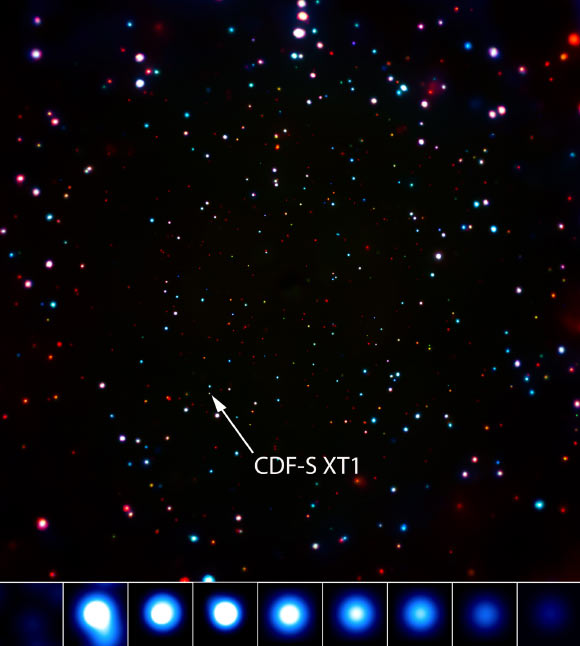An international team of astronomers have discovered a mysterious flash of X-rays using NASA’s Chandra X-ray Observatory, in the deepest X-ray image ever obtained. This X-ray source, located in a region of the sky known as the Chandra Deep Field-South (CDF-S), likely comes from some sort of destructive event, but may be of a variety that astronomers have never seen before.

CDF-S XT1 became 1,000 times brighter over a few hours before fading dramatically in about a day. Image credit: NASA / CXC / Pontifical Catholic University / F.Bauer et al.
The mysterious X-ray source, dubbed CDF-S XT1, has remarkable properties.
Prior to October 2014, it was not detected in X-rays, but then it erupted and became at least a factor of 1,000 brighter in a few hours.
After about a day, the source had faded completely below the sensitivity of Chandra.
Thousands of hours of legacy data from NASA’s Hubble and Spitzer space telescopes helped determine that the event likely came from a faint, small galaxy about 10.7 billion light years from Earth.
For a few minutes, CDF-S XT1 produced a thousand times more energy than all the stars in this galaxy.
“Ever since discovering this source, we’ve been struggling to understand its origin. It’s like we have a jigsaw puzzle but we don’t have all of the pieces,” said lead author Dr. Franz Bauer, from the Pontifical Catholic University of Chile.
Dr. Bauer and co-authors have some ideas of what CDF-S XT1 could be.
Two of the three main possibilities to explain the X-ray source invoke gamma-ray burst (GRB) events, which are jetted explosions triggered either by the collapse of a massive star or by the merger of a neutron star with another neutron star or a black hole.
If the jet is pointing towards the Earth, a burst of gamma-rays is detected. As the jet expands, it loses energy and produces weaker, more isotropic radiation at X-ray and other wavelengths.
Possible explanations for the source are a GRB that is not pointed toward Earth, or a GRB that lies beyond the small galaxy.
A third possibility is that a medium-sized black hole shredded a white dwarf star.
“None of these ideas fits the data perfectly, but then again, we’ve rarely if ever seen any of the proposed possibilities in actual data, so we don’t understand them well at all,” said co-author Dr. Ezequiel Treister, also of the Pontifical Catholic University.
The mysterious source was not seen at any other time during the two and a half months of exposure time Chandra has observed the CDF-S region, which has been spread out over the past 17 years.
Moreover, no similar events have yet to be found in Chandra observations of other parts of the sky.
CDF-S XT1 has different properties from the as yet unexplained variable X-ray sources discovered recently in the elliptical galaxies NGC 5128 and NGC 4636.
In particular, this source is likely associated with the destruction of a neutron star, white dwarf, or massive star, and is roughly 100,000 times more luminous in X-rays.
It is also located in a much smaller and younger host galaxy, and is only detected during a single, several-hour burst.
“We may have observed a completely new type of cataclysmic event. Whatever it is, a lot more observations are needed to work out what we’re seeing,” said co-author Dr. Kevin Schawinski, of ETH Zurich in Switzerland.
The results will be published in the June 2017 issue of the Monthly Notices of the Royal Astronomical Society, but have been published on arXiv.org ahead of time.
_____
F.E. Bauer et al. 2017. A New, Faint Population of X-ray Transients. MNRAS, in press; arXiv: 1702.04422







